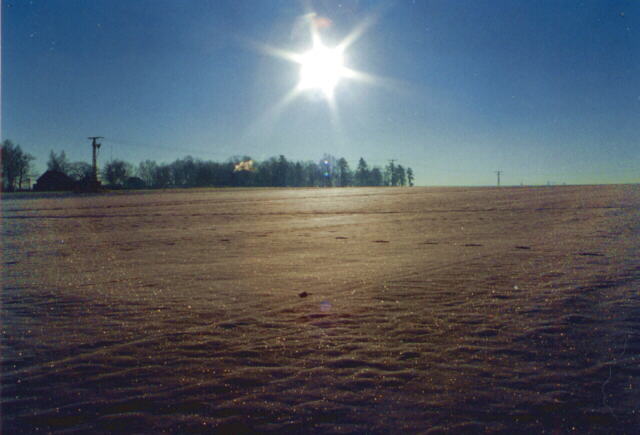by Richard Löwenherz
After a clear and very cold night when the temperature fell to -16,5 C in the early morning (ground temperature -22 C), everything was covered with hoar-frost the crystals of which had the shape of little fans on December 1O. Even the crystals on the surface of the snow were damaged by the frost in such a way that they got structures similar to those of the hoar-frost. When I looked at a rather big undisturbed blanket of snow after sunrise, I was surprised because what I saw there was a kind of "double" halo on the snow. The 22°-halo really was surrounded by a 24°-halo. Up to then, I had hardly thought that such a thing could be possible: Pyramid-shaped ice crystals on a blanket of snow. A 46°-halo also showed up in form of a gathering of colourful spots of light. But this one I could hardly distinguish from the glittering of the frozen snow. Despite of that, it became more distinct as the sun elevation increased (like it was during my first observation of this phenomenon an December 30, 1996), especially on the site where in future the Lausitzring is going to be constructed. (a huge area free of trees).
Like it was the day before, the 3 rings had their greatest intensity on their side rims. As the wind did not play any role that day, this effect probably can only be explained by the concentration of crystals appearing to be greater due to the distance. But it is strange that 1 could not observe this effect at any of my former observations. Up to that day I had always observed the greatest intensity at the lower rim of the ring because due to the increasing distance the spots of light become less intensive towards the horizon and thus become less perceptible for the eye.
Perhaps 1 should first ask where these ice crystals originate!? As a new phenomenon had appeared that was not there the day before, it could not be an effect of the light snow that fell on December 8th and which probably had already lost its influence. So new ice crystals must have been responsible for those strange phenomena. But during the preceding night no snow had fallen. Should it have been hoar-frost that had also formed directly on the surface of the snow during the last night? But what about the hoar-frost on the stems of plants near the ground? Actually there were no refraction effects visible in the fan-shaped hoar-frost crystals on plants. Even the hoar-frost I shook down from the trees could not allude to the 22°-halo by a glittering of its crystals. Observations made in winter 96/97 also show that fan-shaped hoar-frost without any light refraction effects formed even in extremely cold nights. So the hoar-frost does not seem to be the reason for the appearing of the new halos on the snow. But where else did these crystals originate? T. Lehmann reported that he had observed local fields of ground fog on the site of the Lausitzring when he went to school shortly after sunrise. He also mentioned ice crystals floating in the air which glittered in the light of the rising sun. I guess that the appropriate ice crystals had formed as freezing fog and then slowly settled on the ground. That might also have been the reason for the appearing of the 24°-halo, which had never been observed on a blanket of snow before and was last as clearly visible as the 22°-hab. This hypothesis is supported by the fact that halos on a blanket of snow only appeared on lager sites without any trees and not, for example, in a garden, as ground fog mainly forms on areas free of buildings or trees. . While the 24 -halo was only observed on a snow-covered field in the outskirts of the town of Klettwitz, the 22°-halo as well as the 46°-halo also appeared on other sites. It seems that pyramid-shaped ice crystals had only formed in ground fog on a special field and not elsewhere, a fact that delimited the propagation of the 24 -halo even more. Even in plain areas the formation of special ice crystals in freezing fog seems to be subject to local circumstances.
Perhaps the higher concentration of light on the side rims of the rings can be explained by the freezing fog theory if one supposes that due to the calm air the ice crystals reached the ground in a slightly orientated position and so caused increased light refraction near the horizon. I should have examined the structure of the ice crystals in order to authenticate this statement, but unfortunately I had no opportunity to do this.

